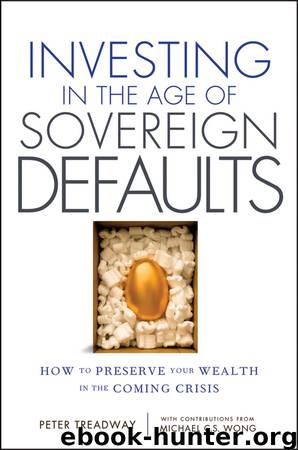Investing in the Age of Sovereign Defaults by Peter T. Treadway & Michael C. S. Wong

Author:Peter T. Treadway & Michael C. S. Wong
Language: eng
Format: epub
Publisher: Wiley
Published: 2012-12-16T16:00:00+00:00
The New World of Quantitative Easing (2001–?)
Technically, the structure of the global monetary system hasn’t changed since the collapse of the Bretton Woods system in 1971–1973. But in fact, the major central banks have entered into a new world of money printing and debasement beginning with the Bank of Japan’s quantitative easing program in 2001. My view is that this new world will eventually end in inflationary chaos and the dawning of a new global financial system.
In the last few years, central banks have come to the realization that there is no limit to the amount of high-powered money printing that they may engage in to prevent financial collapse and deflation. Central banks are printing money all over the world. New names have been given to what is really an age-old phenomenon. Desperate governments have traditionally debased their currencies when they have no other way of financing their deficits. Quantitative easing, LTRO, Fed/ECB swaps, whatever. A new technocratic lexicon has been invented to cover what is really a time-honored expedient of debasement and paper money printing.
This is qualitatively different from the excess money printing and debasement that went on in the past. In the past, monetary authorities printed money and debased their currencies to finance wars. But this time it’s not wars but the prevailing orthodoxy that Keynesian and monetarist demand management policies must be used to micromanage economies; and to finance democracies’ underlying tendency to inexorably move to fiscal excess and bankruptcy.
As I have been arguing, citizens vote to obtain through the political process what they cannot obtain in the market. Modern democratic governments are expected to socialize risk and redistribute income from the smarter affluent minority. The welfare state grows and grows, its costs disguised in the complexity of the budget process and ignored by the public anyway.
And nobody has to bother lifting the fetters of a commodity money conversion requirement that was so important in the age of the classical gold standard before WWI. Richard Nixon cut the last of those golden fetters in 1971 when the United States ceased to honor its commitment under the Bretton Woods Agreement to sell gold for dollars at a fixed rate to other central banks. Since the demise of Bretton Woods, every central bank in the world can be its own ATM machine. And indeed they have.
So far, the world’s central banks have been “lucky.” Thanks to the prior global bubble ending in 2008 and the realization that the so-called advanced countries are reaching the end of their borrowing capacity, the world is in a massive deleveraging mode, which tends to be deflationary. For the moment, the central banks can get away with printing all the money they want without massive increases in consumer price indexes. Especially when the price indexes may have been “calibrated” just a little to present a rosier picture. The public doesn’t connect increases in prices of commodities like gold or oil with the current bout of money printing. But if history is any guide, this
Download
This site does not store any files on its server. We only index and link to content provided by other sites. Please contact the content providers to delete copyright contents if any and email us, we'll remove relevant links or contents immediately.
Rich Dad Poor Dad by Robert T. Kiyosaki(6179)
Pioneering Portfolio Management by David F. Swensen(6081)
How To Win Friends and Influence People by Dale Carnegie(4333)
The Money Culture by Michael Lewis(3849)
The Dhandho Investor by Mohnish Pabrai(3561)
The Wisdom of Finance by Mihir Desai(3526)
Liar's Poker by Michael Lewis(3223)
The Intelligent Investor by Benjamin Graham Jason Zweig(2930)
The ONE Thing by Gary Keller(2919)
Mastering Bitcoin: Programming the Open Blockchain by Andreas M. Antonopoulos(2892)
Fooled by Randomness: The Hidden Role of Chance in Life and in the Markets by Nassim Nicholas Taleb(2861)
Rich Dad Poor Dad: What The Rich Teach Their Kids About Money - That The Poor And Middle Class Do Not! by Robert T. Kiyosaki(2834)
Investing For Dummies by Eric Tyson(2795)
How to Win Friends and Influence People by Dale Carnegie(2794)
How to Day Trade for a Living: Tools, Tactics, Money Management, Discipline and Trading Psychology by Andrew Aziz(2785)
Market Wizards by Jack D. Schwager(2540)
Zero Hour by Harry S. Dent Jr. & Andrew Pancholi(2533)
How to Pay Zero Taxes, 2018 by Jeff A. Schnepper(2500)
Rich Dad's Guide to Investing by Robert T. Kiyosaki(2411)
